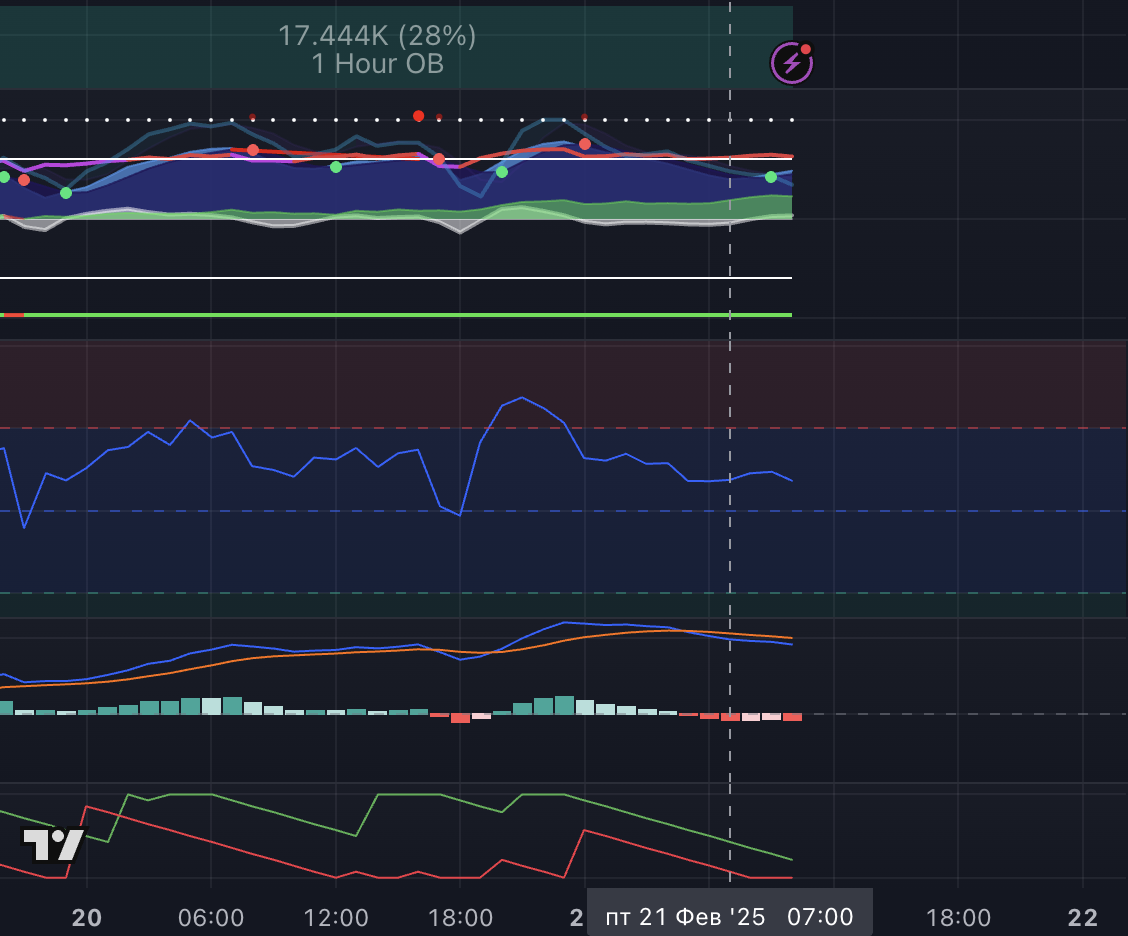Why Cryptocurrency Traders Need Indicators and Technical Analysis in 2025
The cryptocurrency market is one of the most dynamic and unpredictable in the world. Volatility, rapid price movements, constant news, and shifting market sentiment require more than just reactive decisions — traders need a systematic approach. This is where technical indicators come into play.
Indicators help traders:
• Identify the direction of the trend
• Pinpoint entry and exit points
• Measure market strength and trading volume
• Analyze volatility and overbought/oversold zones
• Reduce emotional influence when making decisions
In this article, you’ll get a complete guide to cryptocurrency indicators, including:
• An overview of key indicator types: trend indicators, oscillators, volume, volatility, and sentiment indicators
• Concrete examples: RSI, Bollinger Bands, OBV, MACD, and more
• Recommendations on how to combine them effectively within a trading strategy
If you want to trade with a system rather than guessing — this article is your checklist of the best crypto indicators for 2025.
1️⃣ Trend Indicators: The Foundation of a Successful Crypto Strategy
In 2025, most strategies in the crypto market are still built around understanding the direction of the trend. Trend indicators help traders decide whether to buy, sell, or wait. They don’t just “draw lines” — they provide crucial signals for timing entries and avoiding false moves.
Why use trend indicators?
• Identify global and local trends (uptrend, downtrend, sideways)
• Minimize emotional trading mistakes
• Work across all timeframes — from scalping to long-term investing
Top 3 Trend Indicators for Crypto Trading:
1. Moving Averages (MA, EMA, SMA)
Moving averages smooth out price fluctuations and reveal the overall market direction.
Example: EMA 50 and EMA 200 — classic tools for identifying trends and crossovers (“Golden Cross” and “Death Cross”).
2. MACD (Moving Average Convergence Divergence)
Combines moving averages and histogram analysis to identify reversals and entry points.
Works especially well in combination with RSI and Bollinger Bands.
3. Parabolic SAR
Plots dots above or below candles to signal potential reversals and stop-loss levels.
💡 Pro Tip from Cryptonna:
Combine EMA + MACD + OBV for more accurate signals. You can easily implement this strategy using AI tools built into the Cryptonna platform.
2️⃣ Volume Indicators: How to Measure Market Strength Before It Moves
Volume is one of the most overlooked yet critically important indicators in crypto trading. It shows how strongly market participants support price movement. Without sufficient volume, even the strongest breakout can turn out to be false.
📌 Why monitor volume?
• Volume confirms the strength of a trend
• Helps filter out false signals
• Provides early entry and exit cues
🔍 Top 3 Volume Indicators for the Crypto Market:
1. Volume
A basic indicator showing the total number of trades. Especially useful during breakouts and for gauging interest in an asset.
2. On-Balance Volume (OBV)
Compares volume and price movement: rising OBV along with price indicates “smart” buying.
📌 OBV is integrated into Cryptonna bots and can automatically filter trade entries based on volume.
3. Chaikin Money Flow (CMF)
Measures capital flow. CMF above zero signals buying pressure, while below zero indicates selling pressure.
Works well when paired with RSI and Bollinger Bands.
💡 Pro Tip from Cryptonna:
Want to test a volume-based strategy in real time? Use the built-in signal module + OBV filtering inside Cryptonna’s trading bots. This helps avoid false entries during sideways movement and confirms trade strength.
📎 Additional Resource:
📖 Want to dive deeper into On-Balance Volume? Check out our article “How OBV Works in Crypto Trading” [insert link].
3️⃣ Oscillators: How to Spot Reversals in Sideways Markets and Overheating Phases
When the market isn’t in a clear trend and moves sideways, oscillators become your best friends. These indicators help identify overbought and oversold zones—areas where reversals are most likely to occur.
📌 What do oscillators do?
• Indicate when an asset is overbought or oversold
• Signal potential trend reversals
• Perform best in sideways or ranging markets
🔍 Top 3 Oscillators for Crypto Trading:
1. RSI (Relative Strength Index)
Measures market momentum. Levels above 70 indicate overbought conditions, while below 30 signal oversold.
💡 Cryptonna integrates RSI into strategy templates—you can easily set entry rules based on these thresholds.
2. Stochastic Oscillator
Compares the current price to its range over a period. Especially useful when paired with EMA or Bollinger Bands.
3. CCI (Commodity Channel Index)
Shows how far price deviates from its average. Great for identifying price extremes before potential reversals.
🧠 How to Use Oscillators with ChatGPT and Cryptonna Bots:
• Enter a prompt like: “Create a BTC strategy using RSI and Stochastic with volume filter”
• Get a ready-to-use entry/exit logic
• Import it into your bot via the Cryptonna platform
📎 Related Article:
📖 Want to understand how RSI works with trends? Read our guide “How to Use RSI in Trend Strategies” [insert link]
💬 Takeaway:
Oscillators help you enter the market not out of panic, but with clear signals. If you want to systematically catch reversals—make sure to include RSI, Stochastic, or CCI in your strategy on the Cryptonna platform.
4️⃣ Volatility Indicators: Understanding Market Momentum and Price Swings
In crypto trading, volatility isn’t just a characteristic—it’s an opportunity. Volatility indicators help traders measure the intensity of price fluctuations and identify the best times to enter or exit trades, especially during periods of uncertainty or explosive movements.
Why monitor volatility?
• Volatility defines risk and potential reward
• Helps determine stop-loss and take-profit levels
• Identifies breakout zones and range expansions
🔍 Top 2 Volatility Indicators for Crypto:
1. Bollinger Bands
These are dynamic bands that contract and expand with market volatility.
• Price touching the upper band may indicate overbought conditions
• Price near the lower band may suggest oversold conditions
Bollinger Bands work great in sideways markets and for spotting breakouts.
2. Average True Range (ATR)
ATR measures market volatility based on the average range between high and low prices.
• High ATR = increased volatility
• Useful for setting stop-losses relative to market movement
Pro Tip from Cryptonna:
Use ATR to adjust your position size dynamically. Combine it with Bollinger Bands and trend indicators to identify high-probability breakout zones with better risk management.
5️⃣ Sentiment Indicators: The Psychology of the Crowd in Crypto Trading
In the crypto world—where volatility can reach double digits in a single day—market emotions play a massive role. Sentiment indicators help you understand how the crowd feels: are they afraid, panicking, or moving into a state of euphoria and greed? These tools are essential for every trader’s toolkit.
🔍 Top 4 Popular Sentiment Indicators:
1. Crypto Fear & Greed Index
Measures how emotionally overheated or oversold the market is.
• 0–25 — Extreme Fear (potential buying opportunity)
• 75–100 — Extreme Greed (time to take profits)
2. Long/Short Ratio
Shows the percentage of traders holding long vs short positions on exchanges.
For example, if 80% are long, this could signal an imbalance and possible correction.
3. Social Media Analysis (Twitter, Telegram, Reddit)
AI tools monitor sentiment polarity, crypto mentions, and influencer activity—helping you spot early market shifts.
4. Google Trends
A spike in searches like “buy Bitcoin” or “ETH forecast” often coincides with peak public interest and can signal upcoming corrections.
⚙️ How to Use Sentiment Indicators in Your Strategy:
• During extreme fear levels, consider buying (if confirmed by technical analysis)
• During extreme greed, consider taking profits or tightening stop losses
• Combine with RSI, OBV, MACD, and Bollinger Bands to filter out false signals
📌 Fact: Many institutional investors use sentiment analysis as a “counter-indicator.” Crowd emotion often comes before a reversal.
📢 Cryptonna Tip:
Incorporate sentiment indicators into your trading strategy alongside technical analysis—and make data-driven decisions, not emotional ones.
6️⃣ Specialized Crypto Indicators: Deep-Dive Analytics for Digital Assets
Traditional tools like RSI or MACD are solid, but the crypto market demands unique approaches and specialized instruments. That’s why more traders and analysts now rely on crypto-specific indicators—they go beyond price and include network behavior, staking, transaction activity, and tokenomics.
🔍 Top 5 Specialized Crypto Indicators:
1. NVT Ratio (Network Value to Transactions)
Compares a cryptocurrency’s market cap to its transaction volume.
📌 A high NVT may suggest overvaluation. A low NVT may indicate undervaluation.
2. Staking Indicators
Track how many tokens are locked in staking (e.g., ETH, SOL, ADA).
📌 The higher the staked supply, the lower the circulating supply → potential for price growth.
3. Network Activity (On-Chain Metrics)
Shows active addresses, new wallets, average holding periods.
📌 A rise in these metrics signals growing interest in the project.
4. Hash Rate (for PoW coins)
Especially relevant for Bitcoin and similar assets.
📌 A rising hash rate indicates miner confidence and network security.
5. Liquidity and Locked Tokens Metrics
📊 Tracks token volumes in liquidity pools and those locked in smart contracts.
📈 How to Use These Data Points:
• Assess fundamental strength before mid- or long-term investments
• Filter out low-activity or high-risk tokens
• Identify optimal entry/exit points alongside technical analysis
📌 Fact:
Indicators like NVT and on-chain data often help professional traders forecast price action before it’s visible on the chart.
📢 Cryptonna Tip:
Use specialized crypto indicators in combination with technical and sentiment indicators to gain a 360° view of the market—and secure your edge.
🧠 Conclusion: What Indicators Matter in Crypto Trading & How to Use Them Smartly
The crypto market isn’t just volatility and hype—it’s a complex ecosystem. A skilled trader is an analyst, strategist, and psychologist all at once. Just like a builder uses tools, traders use indicators to uncover insights hidden beneath the surface.
✅ What You Learned in This Guide:
• The main indicator types: trend-following, volume, oscillators, volatility, sentiment, and crypto-specific
• How to use them in various market conditions
• Why combining indicators improves accuracy
• How crypto-specific metrics provide deeper market insights
🚀 How to Start Using Indicators Practically:
1. Choose 1–2 trend indicators (e.g., EMA + MACD)
2. Add a volume tool (OBV or Volume)
3. Include an oscillator (RSI, Stochastic)
4. Factor in volatility (ATR or Bollinger Bands)
5. Add crypto-specific tools for mid/long-term trades
6. Backtest your strategy manually or with dedicated platforms
📌 Cryptonna Tip:
Our platform lets you run strategies using both technical and crypto indicators in fully automated mode. Plus, with TradingView and ChatGPT integration—you can build AI-powered analytics tailored to your goals.
🔗 Bonus Reads:
• How to Choose the Best Indicators for Trading
• AI Strategy Guide for Crypto Trading
💡 Final Thought:
Indicators aren’t magic—they’re tools. But in the right hands, they unlock powerful insights. Customize, analyze, and test your setup—and let Cryptonna support your journey.
❓ Frequently Asked Questions About Crypto Trading Indicators
🔸 What are indicators in crypto trading?
💡 Indicators are analytical tools that help traders interpret price movement, trends, volume, volatility, and other market aspects. They are used to make informed decisions about when to enter or exit trades.
🔸 Which indicators are most accurate for crypto?
💡 No single indicator is 100% accurate—it all depends on your strategy and the market context. However, the most commonly used indicators include RSI, MACD, EMA, and Bollinger Bands, often combined with volume and sentiment indicators.
🔸 How many indicators should I use in a strategy?
💡 Ideally 3 to 5. It’s important to mix different types: trend-following + oscillators + volume/sentiment. Using too many indicators may cause confusion and increase the chance of false signals.
🔸 Can indicators be used in automated trading?
💡 Yes! Platforms like Cryptonna allow you to integrate indicator signals into trading bots that execute trades automatically. This minimizes emotional interference and boosts efficiency.
🔸 Where can I test crypto trading strategies and indicators?
💡 Use TradingView for visual backtesting or demo modes on exchanges like Bybit or Binance. Cryptonna is also developing built-in tools for strategy testing and automation.
📌 Want more real-world crypto analysis examples?
Check out: Top 5 Crypto Trading Strategies with Indicators [insert link]



